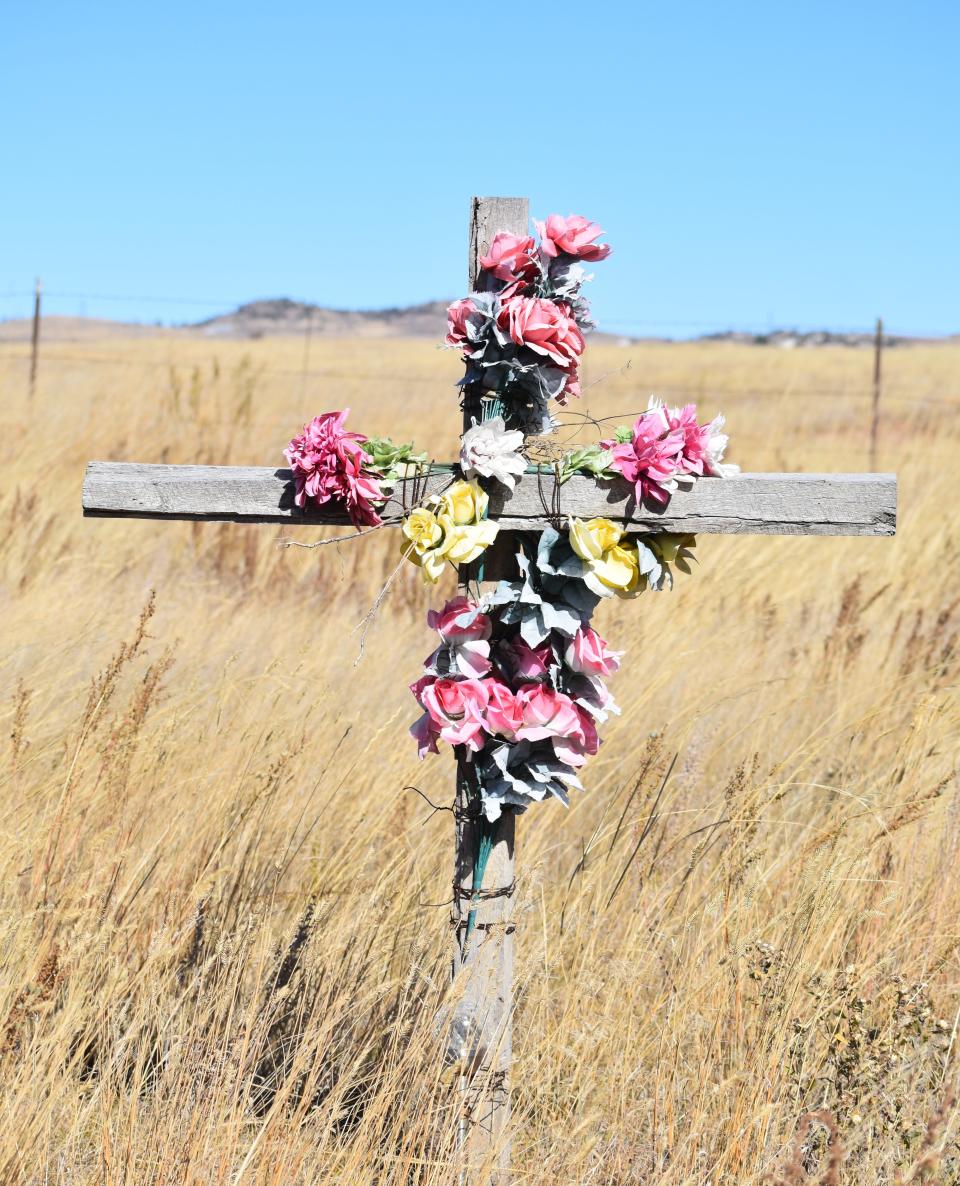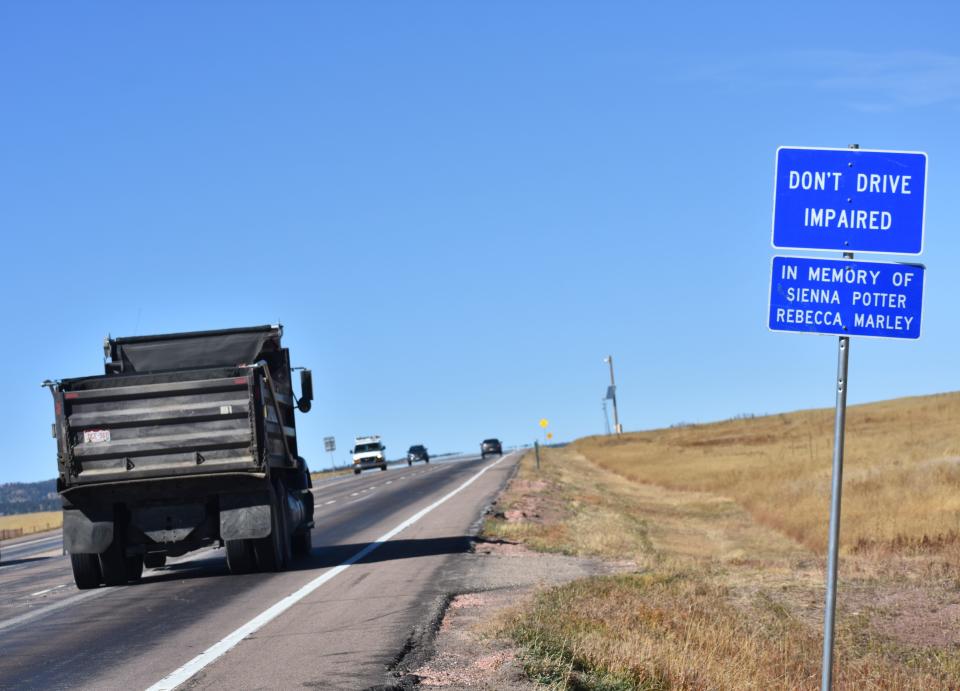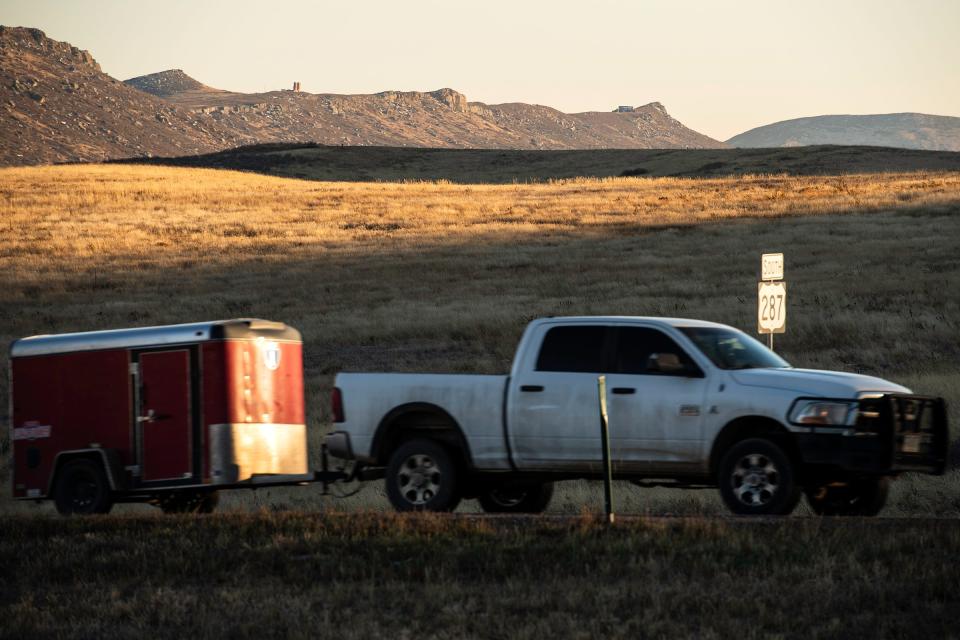'Highway of Death': This stretch of US 287 earned its morbid reputation. Can that change?
Some folks say this ruggedly beautiful section of U.S. Highway 287 on the high plains of northern Larimer County is cursed. Others call it the “Highway of Death."
With 15 fatalities in the last 11 years, including three this year, the 30-mile stretch from Colorado Highway 14 to the Wyoming state line has earned its morbid reputation.
The Colorado Department of Transportation has spent tens of millions of dollars over the last 20 years on efforts to make the road safer, yet the crashes continue. Beefed-up law enforcement has helped, but a lack of funding and troopers in recent years has resulted in hit-or-miss coverage.
It is now conducting a safety study to look for solutions to curb the ongoing safety issues and abnormally high death toll on the highway.
“Band-Aids have been applied and more are coming, but residents say more than Band-Aids are required to stop the bleeding, the carnage," said Margaret Beer, who has seen numerous wrecks from her home between Livermore and Virginia Dale over the past 14 years. "The death, maiming, property damage will only continue to grow until they really start looking at this highway.''
'I told her mom I was talking to her when she left'

Like Beer, Larry Rau saw more than his share of vehicle crash deaths and injuries in the five years he lived along the stretch of U.S. 287 between Livermore and Virginia Dale.
Rau has since moved from his home overlooking the long, lonesome stretch of highway to Missoula, Montana, but memories of wailing sirens, blue lights and first responders in helicopters and ambulances descending on crashes are forever etched in his mind.
The windy and cold late afternoon of Feb. 27, 2021, is an especially painful memory for Rau.
He was driving from his home on the gravel Red Mountain Road to get his mail at the road's intersection with U.S. 287 when he saw a chaotic scene of mangled vehicles, young people crying and walking around dazed, and bodies in a vehicle along the icy highway.
“I knew it didn’t look good,’’ he said, stifling welling emotions. “There was so much commotion, but I was able to cover one of the girls with a blanket and hold on to her through the window. I didn’t know at the time if she was dead, but I kept talking to her. Later, I told her mom I was talking to her when she left.’’
The girl whose hand he held belonged to Sienna Potter, a University of Wyoming student. The mom he spoke with is Trisha Potter, who knows the stretch of U.S. 287 between Fort Collins and Laramie, Wyoming, well. She grew up in Laramie and went to the University of Wyoming before moving to Colorado. Her parents still live in Laramie, where Sienna is buried.
It wasn't until around Sienna's birthday on July 23, 2021, that Trisha, with help from family and friends, finally mustered the courage to visit the crash site.
"I have a love-hate relationship with that stretch with what happened to Sienna," said Trisha Potter, who now lives in Maryland. "Since then, when I drive that stretch, I tell my daughter I love her and miss her.''
Two other University of Wyoming students were killed in the crash, including the driver of the vehicle. He lost control of the vehicle when he hit ice and slid into an oncoming vehicle that struck the car. He was impaired at the time, an investigation revealed.
Rau erected a wooden cross at the crash site. CDOT placed a metal sign reading, "Don't drive impaired'' and "In memory of Sienna Potter Rebecca Marley."

The two fatal crashes resulting in three deaths in 2023 so far involved an impaired vehicle driver and motorcyclist, according to Colorado State Patrol.
"I think marijuana being legal in Colorado but not Wyoming and students driving back and forth is a huge problem," Trisha Potter said.
Fatalities due to impairment have a long history along U.S. 287 from Fort Collins to Laramie. Both cities are home to major universities.
About a dozen University of Wyoming students have been killed on the highway, including eight members of its cross-country team who were killed by an impaired UW student in another vehicle about 17 miles south of Laramie in 2001.
Conundrum of complicating issues makes U.S. Highway 287 more dangerous than it looks
This segment of U.S. 287 has a comfortable Old West feel with expansive views of red rock outcroppings protruding from the wind-swept high plains and highway views that, in places, stretch on for miles.

But beneath that beauty is a beast of complicating driving factors symbolized by the ever-present tire skid marks on the pavement, damaged guard rails and endless safety signs.
There are multiple features that can make this stretch challenging. They include:
A maze of at least 25 roads that intersect the 30-mile stretch, some of which approach at an awkward angle. Several intersections are surprisingly busy, especially at Livermore where the paved Larimer County Road 74E (Red Feather Lakes Road) intersects, along with Owl Canyon Road. The road leading to the Lien and Sons quarry near Owl Canyon Road has a daily volume of limestone-loaded semitrucks.
Enough curves to warrant drivers' undivided attention at the posted speed limit of 65 mph.
Intermittent hills where passing lanes — or “suicide lanes,’’ as some refer to them — have been added to allow vehicles traveling uphill to pass slower vehicles. In Colorado, it is legal for vehicles traveling in the opposite direction of the passing lane to use that lane to pass if it is safe to do so and there are dotted yellow lines, according to state patrol. Passing in this manner is not allowed if there is a double yellow line. Head-on collisions account for a fraction of all crashes here but are the deadliest on this stretch. In the past 11 years, there have been eight head-on crashes resulting in five deaths.
Winter weather on the high plains can at times create treacherous driving conditions due to ice and blowing snow. CDOT data shows 72% of crashes from 2013 to 2022 occurred on dry pavement, while 17% occurred when ice, snow or slush were present on the highway.
Wildlife, mostly deer and elk, that migrate across the road in the fall to their winter grounds.
Those challenges are made more dangerous by common risky driving factors, according to law enforcement and residents. They include impairment, inattentiveness, aggression and speeding.
"Weather can be an issue, not having (undivided) lanes has an impact, but I definitely believe a lot of the issues are people being impaired, distracted and driving too fast for the conditions," Trisha Potter said.
Those natural and driver-related issues are exacerbated by a 53% increase in average daily vehicle numbers over the past decade, including a 27% increase in truck traffic.
"This road was not engineered to carry the huge increase in traffic volume we are seeing, especially with truck traffic," Beer said.
CDOT data shows 17% of overall crashes from 2013 to 2022 involved large trucks, semitrucks and passenger buses. Of those crashes, 82% were caused by the truck, semi or bus.
Vehicle collisions with wildlife, mainly deer, accounted for 34% of the 553 total crashes from 2013 to 2022, by far the most of any cause, according to CDOT data.
Those numbers spike in November.
Despite the frequency of crashes involving wildlife, few injuries and no deaths have occurred with these collisions. None of the 30 miles of the highway rank high enough in vehicle vs. wildlife collisions to add more safety measures to those in place, which currently include wildlife warning signs, according to CDOT data.
“About this time of year, the deer start moving at dusk and dawn and you frequently see them," Beer said. “If driving early in the morning, I keep one foot hovering over the brake pedal in areas you often see them."
More: Colorado drivers kill thousands of wildlife each year. Here's how to prevent those crashes
Safety solutions for U.S. Highway 287 not a simple matter
With so many crash variables, CDOT and Colorado State Patrol are looking at multiple remedies for what ails the highway.
CDOT has already laid down rumble strips; added or lengthened passing, acceleration and de-acceleration lanes; installed additional guard rails and erected an assortment of safety signs.
Stephanie Gramberg, CDOT's construction manager for the region, said the department has $10 million to spend on corridor projects over the next five years. She said projects identified as the result of the safety study, which included input from the public, could start in 2025.
Wyoming divided U.S. 287 with a median in places along its 23 miles of the highway from the state line to Laramie to reduce fatal crashes. One of the sections it divided was near Tie Siding, the site of the 2001 crash that killed eight members of the Wyoming cross-country team.
Gramberg said CDOT would need to evaluate the cost and benefit of dividing the highway, which far exceeds funding it currently has, after implementing projects that could more immediately improve safety with the funds it has allocated.
"I believe we can improve safety a lot at intersections by creating acceleration and de-acceleration lanes and by widening shoulders on portions of the corridor," she said. "These may help minimize rear-ends and risky turning decisions. Unfortunately, we can't control drivers that are disobeying the law and putting themselves and others at danger."
Trisha Potter is hopeful the safety study will result in saved lives, but knows for Sienna and her family, any improvements will come too late.
"It's all the things missing from our lives," she said. "She would be a senior, be graduating and starting a career. She never got a chance to get married. There will be no mother-daughter vacations that we had planned. That makes it really hard."
Law enforcement's role in improving safety on U.S. Highway 287
Colorado State Patrol Capt. Bart Trippel, who oversees the troop responsible for covering Larimer County, said the road comes up often in discussions between state patrol, Larimer County Sheriff's Office and CDOT.
He believes it will take a concerted effort of engineering, education and enforcement by all parties to curtail crashes.
He said state patrol heavily patrolled the stretch of highway in recent years, leading to zero fatalities in 2022 despite the agency struggling to hire enough troopers to adequately cover the county.
"It was time-consuming, but the zero fatalities in 2022 was unheard of in my time here,'' Trippel said. "We proved law enforcement visibility works, but staffing hasn't kept up and we haven't had regular patrols this year and we had three fatalities."
He said three recent trooper hires will help the agency beef up patrols in 2024.
He is unsure if a reduction to the current speed limit of 65 mph is necessary because the road is equipped to handle that speed. He said increased law enforcement could reduce impaired driving.
"The road requires your attention when you combine curves, speed and not paying attention, and you can't concentrate if you are impaired," he said. " We will have the ability to patrol it more in 2024. It would be nice to get another nonfatal year like in 2022, but we know realistically this road has a reputation for bad crashes."
Border War impaired patrols slated for Friday game
Law enforcement agencies from Colorado and Wyoming will be conducting impaired driving patrols before, during after the 6 p.m., Friday, Nov. 3 football game between CSU and the University of Wyoming in Laramie.
Patrols will occur along U.S. Highway 287 and Interstate 25 between Fort Collins and Laramie.
Motorists can report unsafe drivers to Colorado State Patrol by dialing *277.
This article originally appeared on Fort Collins Coloradoan: US 287 between Highway 14 and Wyoming is deadly. Can that change?

